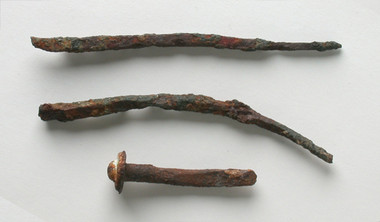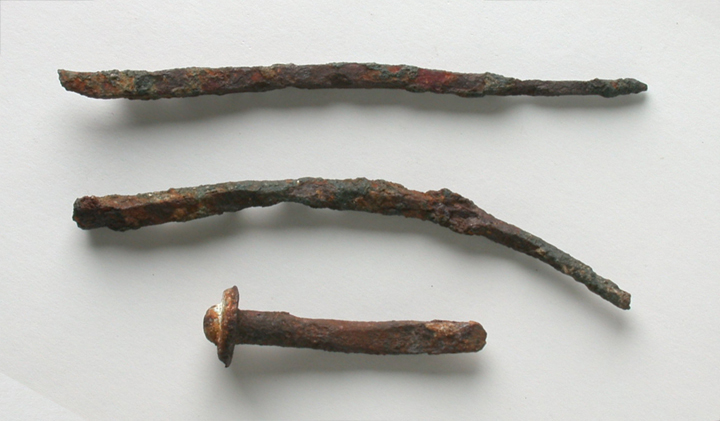Nails, Ancient Rome, Original
Nails keep structures and buildings from falling apart. There are very few buildings that do not use nails to keep shelves, sockets and pictures on walls, carpets and floorboards on the floor, and door and window frames in position. The use of the nail is universal.
These nails are all original Roman nails. The wood from Roman buildings has long since decayed, but the nails are still strong enough to be used today. The two shorter nails are 6 1/2 cm and are made out of iron. They are both bent from use, having been subject to the double pressures of being hammered into a resistant surface, and having to support the shelf, light, door or window frame that was being built. The top of each nail is wider than the spike. This prevented the nail from being hammered so hard into the wall that it became lost. It also allowed the builder to have more chance of actually hitting the nail, rather than his / her finger, as the nail has to be held while hammering to guide it into place.
The two longer nails were used for a different purpose. The spikes are 15 cm long in order to penetrate further into the material. They may have been used to hold roof tiles in place, stretching through both tile and roof frame, or to support heavier loads by having the security of more depth to keep them stable.
These nails are all original Roman nails. The wood from Roman buildings has long since decayed, but the nails are still strong enough to be used today. The two shorter nails are 6 1/2 cm and are made out of iron. They are both bent from use, having been subject to the double pressures of being hammered into a resistant surface, and having to support the shelf, light, door or window frame that was being built. The top of each nail is wider than the spike. This prevented the nail from being hammered so hard into the wall that it became lost. It also allowed the builder to have more chance of actually hitting the nail, rather than his / her finger, as the nail has to be held while hammering to guide it into place.
The two longer nails were used for a different purpose. The spikes are 15 cm long in order to penetrate further into the material. They may have been used to hold roof tiles in place, stretching through both tile and roof frame, or to support heavier loads by having the security of more depth to keep them stable.

Long straight nail length:15.3cm
The Romans used tools that are familiar to us today. Nails, hammers, chisels, saws, trowels, folding rulers, dividers and plumb lines, were commonly used.
The Romans were highly skilled builders. In the second century BC, they developed concrete, using volcanic dust mixed with lime. They began using this in preference to traditional materials as it was cheap, would not catch fire, and opened new possibilities for building. It could be poured into and over timber frameworks, and enabled the Romans to build huge vaults and domes, aqueducts and bridges, amphitheatres and harbours. Rome itself was largely rebuilt in concrete, faced with brick, after the Great Fire in AD 64.
The Roman army placed great importance upon building, engineering and surveying. They constructed solid defences, and good roads to move troops and supplies. During peacetime they helped to plan and build towns, and the remains of many of these towns can still be seen. A typical Roman town included a wide variety of public buildings, as well as housing. The public baths had a hot room, a cold room, and a steam room to cleanse the skin. The forum was the central focus and meeting place of the town. The temple was a place of worship, and the amphitheatre was an open-air circular building similar to a sports stadium today, where fights and races were held.
The Romans were highly skilled builders. In the second century BC, they developed concrete, using volcanic dust mixed with lime. They began using this in preference to traditional materials as it was cheap, would not catch fire, and opened new possibilities for building. It could be poured into and over timber frameworks, and enabled the Romans to build huge vaults and domes, aqueducts and bridges, amphitheatres and harbours. Rome itself was largely rebuilt in concrete, faced with brick, after the Great Fire in AD 64.
The Roman army placed great importance upon building, engineering and surveying. They constructed solid defences, and good roads to move troops and supplies. During peacetime they helped to plan and build towns, and the remains of many of these towns can still be seen. A typical Roman town included a wide variety of public buildings, as well as housing. The public baths had a hot room, a cold room, and a steam room to cleanse the skin. The forum was the central focus and meeting place of the town. The temple was a place of worship, and the amphitheatre was an open-air circular building similar to a sports stadium today, where fights and races were held.

Long straight nail length:15.3cm

Nails keep structures and buildings from falling apart. There are very few buildings that do not use nails to keep shelves, sockets and pictures on walls, carpets and floorboards on the floor, and door and window frames in position. The use of the nail is universal.
These nails are all original Roman nails. The wood from Roman buildings has long since decayed, but the nails are still strong enough to be used today. The two shorter nails are 6 1/2 cm and are made out of iron. They are both bent from use, having been subject to the double pressures of being hammered into a resistant surface, and having to support the shelf, light, door or window frame that was being built. The top of each nail is wider than the spike. This prevented the nail from being hammered so hard into the wall that it became lost. It also allowed the builder to have more chance of actually hitting the nail, rather than his / her finger, as the nail has to be held while hammering to guide it into place.
The two longer nails were used for a different purpose. The spikes are 15 cm long in order to penetrate further into the material. They may have been used to hold roof tiles in place, stretching through both tile and roof frame, or to support heavier loads by having the security of more depth to keep them stable.
These nails are all original Roman nails. The wood from Roman buildings has long since decayed, but the nails are still strong enough to be used today. The two shorter nails are 6 1/2 cm and are made out of iron. They are both bent from use, having been subject to the double pressures of being hammered into a resistant surface, and having to support the shelf, light, door or window frame that was being built. The top of each nail is wider than the spike. This prevented the nail from being hammered so hard into the wall that it became lost. It also allowed the builder to have more chance of actually hitting the nail, rather than his / her finger, as the nail has to be held while hammering to guide it into place.
The two longer nails were used for a different purpose. The spikes are 15 cm long in order to penetrate further into the material. They may have been used to hold roof tiles in place, stretching through both tile and roof frame, or to support heavier loads by having the security of more depth to keep them stable.




















